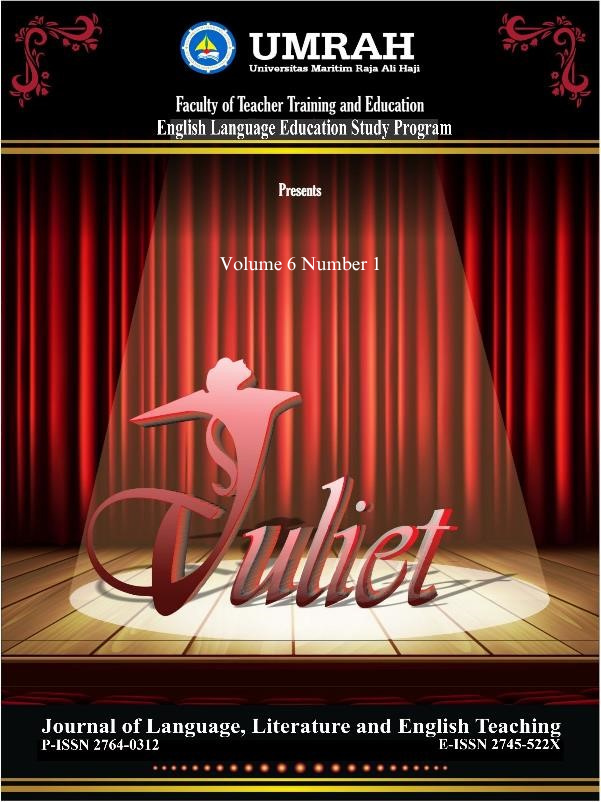Building Confidence: Reducing Speaking Anxiety Among Blitar's EFL Students in the Post-Covid-19 era
DOI:
https://doi.org/10.31629/y8yeka57Keywords:
Speaking anxiety, Relaxation, Preparation, Resignation, Small TalkAbstract
The COVID-19 pandemic necessitates a shift to online learning, which often results in more passive experiences for Students who majoring in sociology in Blitar. Despite the challenges of acquiring proficiency in a foreign language like English, many third-year students remain determined to improve their speaking skills and communication abilities to support their careers. The study aimed to understand the strategies students employed to overcome speaking anxiety in social interaction. Through semi-structured interviews and classroom observations, the research identified three primary approaches: collecting, grouping, and summarizing. The twelve Sociology students emphasized the importance of preparation in speaking, including studying and practicing pronunciation. A significant majority (84%) of students believed in the power of preparation, while 24% relied on relaxation techniques to manage anxiety. A smaller group (12%) exhibited minimal participation in speaking, reflecting a state of resignation. Engaging in small talk was identified as a potential strategy to address the challenges faced by students experiencing speaking anxiety in the classroom.
References
Afidawati, H., Arrasyid, F. I., & Ikawati, L. (2024). Minimizing EFL Learners’ Speaking Anxiety in the Post-Pandemic Era. JEELS (Journal of English Education and Linguistics Studies), 11(1), 107–130. https://doi.org/10.30762/jeels.v11i1.1886
Cohen, L., Manion, L., & Morrison, K. (2018). Research methods in education (eighth edition). Routledge.
Creswell, J. W., & Creswell, J. D. (2023). Research Design Qualitative, Quantitative, and Mixed Methods Approaches (6th ed.). SAGE.
Dyah Budiastuti, A. (2018). Validitas dan reliabilitas penelitian: Dilengkapi analisis dengan NVIVO, SPSS, dan AMOS. Mitra Wacana Media. https://lib.ui.ac.id
Febria, D., & Marsevani, M. (2024). The Post-Pandemic Reflection on Students’ Speaking Anxiety: A Case in Higher Education. Linguists : Journal of Linguistics and Language Teaching, 10(1), 1. https://doi.org/10.29300/ling.v10i1.4492
Ghosh, N., Goyal, S., Howard, A., Banerjee, P., & Vitale, J. (2023). Application of Nanotechnology in a Novel Air Purifier for Remediation of Airborne Pathogen and to Prevent the Spread of COVID-19. European Scientific Journal, ESJ, 19(12), Article 12. https://doi.org/10.19044/esj.2023.v19n12p1
Grellier, J., & Goerke, V. (2018). Communications Toolkit (D. Campbell-Avenell, Ed.; 4th edition). 1010 Printing International Limited.
Hakim, R. N. A. A., & Syam, H. (2019). An analysis of students’ anxiety in speaking English at MAN 1 Kolaka. ELT Worldwide: Journal of English Language Teaching, 6(2), 127–137. https://doi.org/10.26858/eltww.v6i2.10486
He, D. (2018). Foreign language learning anxiety in China: Theories and applications in English language teaching (Vol. 24). Springer Nature Singapore. https://www.tandfonline.com/doi/full/10.1080/13670050.2018.1545745
Jamshidnejad, A. (Ed.). (2020). Speaking English as a Second Language: Learners’ Problems and Coping Strategies. Springer International Publishing. https://doi.org/10.1007/978-3-030-55057-8
Kondo, D. S., & Ying-ling, Y. (2004). Strategies for coping with language anxiety: The case of students of English in Japan. ELT Journal, 58(3), 258–265. https://doi.org/10.1093/elt/58.3.258
Limbong, S., Jabu, B., & Basri, M. (2022). The Impact of Synchronous Learning of Marlins in Teaching Maritime English. Journal of Learning and Development Studies, 2(3), 06–13. https://doi.org/10.32996/jlds.2022.2.3.2
Milanrianto, B. A., Permana, D., & Ariani, S. (2023). Cognitive and Social Strategies to Deal With Anxiety in Speaking: Typical Strategies and Application. Journal of Languages and Language Teaching, 11(3), 502. https://doi.org/10.33394/jollt.v11i3.8441
Nurahman, R. K., Hidayat, I. N., & Rosyid, A. (2023). Students’ Strategies In Coping With Anxiety In Speaking English. Paradigma, 20(1), 96–113. https://doi.org/10.33558/paradigma.v20i1.5936
Nuraini, I., Amri, S., & Maizarah. (2024). Students’ strategies for reducing anxiety in speaking English at Madrasah Aliyah Nurul Jihad Tembilahan Hulu. J-Shelves of Indragiri (JSI), 6(1), Article 1. https://doi.org/10.61672/jsi.v6i1.2733
Pawlak, M., Zawodniak, J., & Kruk, M. (2020). Boredom in the Foreign Language Classroom: A Micro-Perspective. Springer International Publishing. https://doi.org/10.1007/978-3-030-50769-5
Peng, R., Wang, S., & Liu, N. (2024). Factors influencing Chinese EFL students’ online learning anxiety in the post-COVID-19 era. Heliyon, 10(4), e26112. https://doi.org/10.1016/j.heliyon.2024.e26112
Rosita, E., & Halimi, S. (2023). The Use of Flipgrid in Improving Secondary School Teachers’ Motivation and Confidence in Speaking English. JEELS (Journal of English Education and Linguistics Studies), 10(1), Article 1. https://doi.org/10.30762/jeels.v10i1.842
Sri Rahayuningsih, T. I. S. (2022). Exploring English Teacher’s Teaching Strategies to Build Students’ Confidence to Practice Speaking English. JADEs Journal of Academia in English Education, 3(1), 51–70. https://doi.org/10.32505/jades.v3i1.3833
Sulistyowati, D., Yasin, M., Setiaji, J., Listyaningrum, N., Adriani, R. B., Sari, D., Setyaningsih, R., Rivai, A., Sunaryanti, B., Aini, I., Santosa, B., & Adam. (2022). Buku Ajar Sosiologi. Zahir Publishing.
Sylvia, T., Rochmawati, L., Novalina, S. D., Saragih, N. A., & Rosyid, H. (2024). E-aviation speaking preparation test for aviation vocational school. International Journal of Evaluation and Research in Education (IJERE), 13(6), Article 6. https://doi.org/10.11591/ijere.v13i6.28561
Szyszka, M. (2017). Pronunciation Learning Strategies and Language Anxiety. Springer International Publishing. https://doi.org/10.1007/978-3-319-50642-5
Tanveer, M. (2008). Investigation of the factors that cause language anxiety for ESL/EFL learners in learning speaking skills and the influence it casts on communication in the target language. https://doi.org/10.13140/RG.2.1.1995.1129
Tetrapoik, D., Lekawael, R. F. J., & Tiwery, D. S. (2022). Students’ Strategies to Overcome Anxiety in Speaking English at The Second Grade Students Of SMK Negeri 6 MBD. Koli Journal : English Language Education, 3(1), Article 1. https://doi.org/10.30598/koli.3.1.21-31
Ulayya, N. K., & Anggraini, H. W. (2024). Understanding Classroom Activities in Speaking Courses in College: A Case Study in the Post-Pandemic Era. Journal of Ultimate Research and Trends in Education, 6(1), 70–81. https://doi.org/10.31849/utamax.v6i1.19337
Verdiyeva, S., & Huseynova, F. (2017). Speaking is a Challenging Skill in Language Learning. International Journal of English Literature and Social Sciences, 2(6). https://ijels.com/detail/speaking-is-a-challenging-skill-in-language-learning/
Yang, P. L. (2022). Exploring Synchronous Learning during COVID-19 Pandemic: Taiwan EFL College Learners’ Motivation and Learning Experience. AsiaCALL Online Journal, 13(5), 1–14. https://doi.org/10.54855/acoj.221351
Downloads
Published
Issue
Section
License
Copyright (c) 2025 Author

This work is licensed under a Creative Commons Attribution 4.0 International License.





